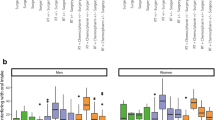Abstract
Purpose
The purpose of this study was to test the validity of the Head and Neck Patient Symptom Checklist (HNSC).
Methods
Three hundred and sixty-eight treatment-naive individuals with head and neck cancer prospectively completed the HNSC and the Patient-Generated Symptom Global Assessment (PG-SGA). The predictive validity was determined by comparing the HNSC symptoms interference scores to the PG-SGA scores. Multivariate logistic regression was used to determine the HNSC symptoms scores associated with reduced dietary intake, ≥5 % weight loss over 6 months, and reduced functional performance (FP).
Results
HNSC sensitivity (79–98 %), specificity (99–100 %), positive predictive value (92–100 %), and negative predictive value (94–100 %) were excellent, and the Cronbach's alpha coefficient was 0.92. The multivariate logistic regression showed that advanced tumor stage, pain, loss of appetite (LOA), and difficulty swallowing significantly predicted dietary intake. Advanced tumor stage, LOA, and difficulty swallowing were also significant predictors of ≥5 % weight loss over 6 months. LOA, difficulty swallowing, feeling full, and lack of energy were significant predictors of reduced FP.
Conclusions
The HNSC appears to be a valid tool for determining symptoms interfering with dietary intake of head and neck cancer (HNC) patients. This instrument may aid in early identification of symptoms that place HNC patients at risk for reductions in dietary intake, weight, and functional performance.
Similar content being viewed by others
References
DeWys WD, Begg C, Lavin PT et al (1980) Prognostic effect of weight loss prior to chemotherapy in cancer patients. Eastern Cooperative Oncology Group. AJM 69:491–497
Couch M, Lai V, Cannon T et al (2007) Cancer cachexia syndrome in head and neck cancer patients: part 1. Diagnosis, impact on quality of life and survival, and treatment. Head Neck 29(4):401–411
Baracos VE (2006) Cancer-associated cachexia and underlying biological mechanisms. Annu Rev Nutr 26:435–461
Tisdale MJ (2002) Cachexia in cancer patients. Nat Rev Cancer 2:862–871
Grosvenor M, Bulcavage L, Chelbowski RT (1989) Symptoms potentially influencing weight loss in a cancer population. Correlations with primary site, nutritional status, and chemotherapy administration. Cancer 63(2):330–334
Kubrak C, Olson K, Jha N et al (2010) Nutritional impact symptoms: key determinants of reduced dietary intake, weight loss, and reduced functional capacity of head and neck cancer patients prior to treatment. Head Neck 32(3):290–300
Kubrak C, Jensen L (2007) Critical evaluation of nutrition screening tools recommended for oncology patients. Cancer Nurs 30(5):E1–E6
Larsson M, Gedelin B, Athlin E (2003) Lived experiences of eating problems for patients with head and neck cancer during radiotherapy. J Clin Nurs 12(4):562–570
Mundform DJ, Shaw DG, Ke TL (2005) Minimum sample size recommendations for conducting factor analyses. IJT 5(2):159–168
Bauer J, Capra S, Ferguson M (2002) Use of the scored patient-generated subjective global assessment (PG-SGA) as a nutrition assessment tool in patients with cancer. Eur J Clin Nutr 56:779–785
Valanis B (1986) Epidemiology in nursing and health care. Appleton-Century-Crofts, Connecticut
Salkind NJ (2008) Statistics for people who (think they) hate statistics, 3rd edn. Sage Publications, California
Mickey J, Greenland S (1989) A study of the impact of confounder selection criteria on effect estimation. Am J Epidemiol 129:125–137
Sarhill N, Mahmoud F, Walsh D et al (2003) Evaluation of nutritional status in advanced metastatic cancer. Support Care Cancer 11:652–659
Khalid U, Spiro A, Baldwin C et al (2007) Symptoms and weight loss in patients with gastrointestinal and lung cancer at presentation. Support Care Cancer 13:39–46
Jager-Wittenaar H, Dijkstra PU, Vissink A et al (2007) Critical weight loss in head and neck cancer—prevalence and risk factors at diagnosis: an explorative study. Support Care Cancer 15:1045–1050
Grant M, Kravits K (2000) Symptoms and their impact on nutrition. Semin Oncol Nurs 16(2):113–121
Payne R, Foley KM (1985) Advances in the management of cancer pain. Cancer Treat Rep 68:173–179
Frese M, Zapf D (1988) Methodological issues in the study of work stress: objective vs. subjective measurement of work stress and the question of longitudinal studies. In: Cooper CL, Payne R (eds) Causes, coping and consequences of stress at work. Wiley, Chichester
Coughlin S (1990) Recall bias in epidemiological studies. J Clin Epidemiol 43(1):87–91
McClement S (2005) Cancer anorexia-cachexia syndrome. Psychological effect on the patient and family. J Wound Ostomy Continence Nurs 32(4):264–268
Greene F et al (2002) AJCC cancer staging manual, 6th edn. Springer, Heidelberg
Acknowledgments
This research was supported by the South Lioness Club Scholarship in Nursing and the Queen Elizabeth II Scholarship awarded to the first author.
Conflict of interest
We declare that we have no conflict of interest for this study.
Author information
Authors and Affiliations
Corresponding author
Appendix
Appendix
Rights and permissions
About this article
Cite this article
Schmidt, K.N., Olson, K., Kubrak, C. et al. Validation of the Head and Neck Patient Symptom Checklist as a nutrition impact symptom assessment tool for head and neck cancer patients. Support Care Cancer 21, 27–34 (2013). https://doi.org/10.1007/s00520-012-1483-y
Received:
Accepted:
Published:
Issue Date:
DOI: https://doi.org/10.1007/s00520-012-1483-y




